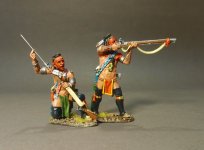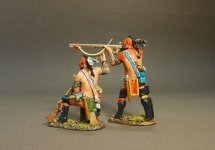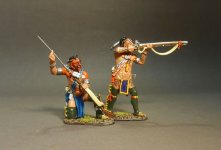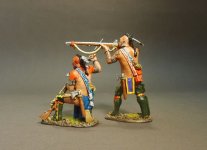You are using an out of date browser. It may not display this or other websites correctly.
You should upgrade or use an alternative browser.
You should upgrade or use an alternative browser.
NEW RELEASES FOR JUNE 2014 - French & Indian Wars (1 Viewer)
- Thread starter jjDesigns
- Start date
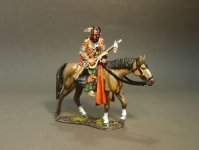
RSF-23A
THE RAID ON ST. FRANCIS,
Mounted Woodland Indian, Tracking,
(2pcs)
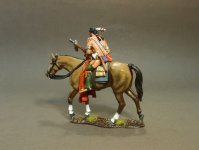
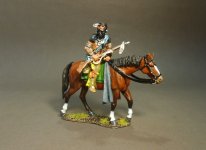
RSF-23B
THE RAID ON ST. FRANCIS,
Mounted Woodland Indian, Tracking,
(2pcs)
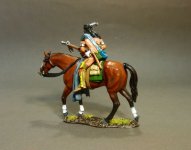
**PLEASE NOTE RSF-23 comes in 2 colour schemes **
THE BATTLE OF THE PLAINS OF ABRAHAM 1759
During the reign of Queen Anne of Great Britain the English Army had become very disorganized and undisciplined. The Hanoverians (George I) who succeeded Queen Anne in 1714 reorganized the English Army, requiring the troops to march in step to proper military music. Thus fife & drum music was adopted by the British military (except for the Scottish regiments).
A company of about 100 men would have one or two fifers, and one or two drummers. When 8 or 10 companies were gathered together to form a regiment, their fifers and drummers were “banded” to form a regimental band.
The musicians provided music for the army on the march. As Napoleon would prove, music would be very effective in motivating an army to march long distances. The musicians were also used to broadcast various signals. Military camp life required a succession of daily signals: time to get up, breakfast call, sick call, assembly, lunch, duty calls, dinner, evening retreat, lights-out (curfew).
The “Tattoo” comes from the Dutch die den tap toe which was a signal for the beer sellers to “turn off the taps” so that the soldiers could finish their beers and report back to camp. This signal consisted of the fifes and drums marching up and down the streets of the garrison town or camp, playing as they marched - at the end, they would stop marching, and conclude with a hymn.
While the army was encamped (or billeted in a city) the “officer of the day” (supervising at that moment) would always have a drummer with him to give impromptu and emergency signals: to sound “alarm” at an imminent attack or to call for a conference of the officers.
Contrary to common opinion, signals generally were NOT given during battles, excepting “cease fire” and related signals. The battlefield was too noisy and confusing, and, as the French discovered when they experimented with the idea in the 1750’s, the enemy can hear your signals.
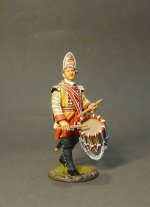
QB-33
BATTLE OF THE PLAINS OF ABRAHAM,
13th September 1759, British, 35th Regiment of Foot, Drummer,
(1pc)
To be continued........................
THE JACOBITE REBELLION 1745
Barrell’s Regiment , the 4th Regiment of Foot, were to bear the brunt of the Jacobite attack on Cumberland’s left flank at Culloden. Since it was a Royal regiment, the drummer was issued with a red coat faced with blue. Drummers of non royal regiments wore coats of the facing colour , and were faced red.
There were normally two drummers per company in a regiment.
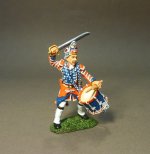
BJ-15
THE JACOBITE REBELLION 1745
4th Regiment of Foot (Barrell’s) British Drummer,
1 Figure (1pc)
Limited Edition 500
FOR FURTHER INFORMATION, PRICES AND AVAILABILITY, PLEASE CONTACT YOUR REGULAR DEALER.
Barrell’s Regiment , the 4th Regiment of Foot, were to bear the brunt of the Jacobite attack on Cumberland’s left flank at Culloden. Since it was a Royal regiment, the drummer was issued with a red coat faced with blue. Drummers of non royal regiments wore coats of the facing colour , and were faced red.
There were normally two drummers per company in a regiment.

BJ-15
THE JACOBITE REBELLION 1745
4th Regiment of Foot (Barrell’s) British Drummer,
1 Figure (1pc)
Limited Edition 500
FOR FURTHER INFORMATION, PRICES AND AVAILABILITY, PLEASE CONTACT YOUR REGULAR DEALER.
mikemiller1955
Lieutenant General
- Joined
- Aug 3, 2008
- Messages
- 17,495
aaaaaaah...more Indians...goody...goody...goody!!!!!
gotta say...
Barrel's drummer has the most ornate uniform I have seen in a while...
I bet he was a prime target in a battle...
gotta say...
Barrel's drummer has the most ornate uniform I have seen in a while...
I bet he was a prime target in a battle...
Larry Allen
2nd Lieutenant
- Joined
- Nov 5, 2007
- Messages
- 3,876
Oh heavens ... more wonderful, superb, fantastic, incredible ..... INDIANS!!!!! {sm3} {sm3}
Looks like another trip down to the Blood Bank this month ......
--- Larry
Looks like another trip down to the Blood Bank this month ......
--- Larry
Cairnbeg
Private 1st Class
- Joined
- Jan 20, 2013
- Messages
- 243
THE JACOBITE REBELLION 1745
Barrell’s Regiment , the 4th Regiment of Foot, were to bear the brunt of the Jacobite attack on Cumberland’s left flank at Culloden. Since it was a Royal regiment, the drummer was issued with a red coat faced with blue. Drummers of non royal regiments wore coats of the facing colour , and were faced red.
There were normally two drummers per company in a regiment.
View attachment 152019
....personally, that's exactly what was needed for my collection.....as for all of the other JJD releases, WOW !
Dragoon
Sergeant Major
- Joined
- Apr 27, 2005
- Messages
- 1,867
....personally, that's exactly what was needed for my collection.....as for all of the other JJD releases, WOW !
Very happy to see a Jacobite Rebellion release of the fighting drummer for Barrell's 4th.... Looking forward to the upcoming falling wounded, and NCO sets.
Some great things being created by JJD for WWI, the period seems to have really caught John's interest........Budget, display space, massive size and tragic waste of the actual conflict, all have kept me away from collecting WWI. - But all these wonderful new pieces John is creating for the Great War is making it very, very hard to stay away.
nysoldiers
Command Sergeant Major
- Joined
- Mar 15, 2008
- Messages
- 2,372
Very happy to see a Jacobite Rebellion release of the fighting drummer for Barrell's 4th.... Looking forward to the upcoming falling wounded, and NCO sets.
Some great things being created by JJD for WWI, the period seems to have really caught John's interest........Budget, display space, massive size and tragic waste of the actual conflict, all have kept me away from collecting WWI. - But all these wonderful new pieces John is creating for the Great War is making it very, very hard to stay away.
I had the same concerns and only collected JJD WWI planes.
Given some hints, however, of what is to come for this range I will be a buyer.
I can only say that earlier vehicles for 1916/17 battles are in the works.
,
theBaron
Major
- Joined
- Mar 27, 2008
- Messages
- 10,370
Great additions to the line!
The mounted Indian's horse and tackle would have been a war prize, or traded for, wouldn't they. Horses were hunted to extinction by the Indians' predecessors in North America, and were re-introduced by the Spanish, in the 1600s.
The Brits would fit in for the western German theater, too, wouldn't they.
Nicely done, prosit!
Brad
The mounted Indian's horse and tackle would have been a war prize, or traded for, wouldn't they. Horses were hunted to extinction by the Indians' predecessors in North America, and were re-introduced by the Spanish, in the 1600s.
The Brits would fit in for the western German theater, too, wouldn't they.
Nicely done, prosit!
Brad
Users who are viewing this thread
Total: 2 (members: 0, guests: 2)


